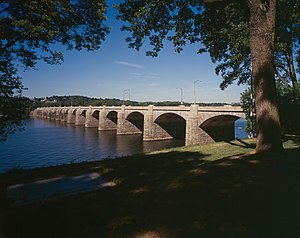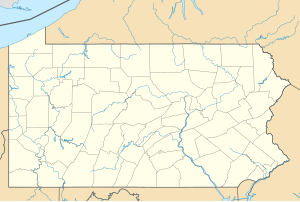Market Street Bridge (Harrisburg, Pennsylvania)
| Market Street Bridge | |
| U.S. National Register of Historic Places | |
|
HAER photo of the Market Street Bridge
|
|
| Country | United States |
|---|---|
| State | Pennsylvania |
| County | Cumberland, Dauphin |
| City | Harrisburg |
| Road | Market Street and BicyclePA Route J (4 lanes) |
| Crosses | Susquehanna River |
| Coordinates | 40°15′24″N 76°53′5″W / 40.25667°N 76.88472°WCoordinates: 40°15′24″N 76°53′5″W / 40.25667°N 76.88472°W |
| Length | 1,415 ft (431 m) |
| - Mainspan | 89 ft (27 m) |
| Width | 59 ft (18 m) |
| Architect | Modjeski & Masters, Paul Philippe Cret |
| Material | Stone |
| Built | 1928 |
| Governing Body | PennDOT |
| NBI Number | 223012003000000 |
| NRHP Ref Number | 88000759 |
| ADT | 12,825 |
| Load | 49 metric tons (54 short tons) |
| Added to NRHP | June 22, 1988 |
| MPS | Highway Bridges Owned by the Commonwealth of Pennsylvania, Department of Transportation TR |
The Market Street Bridge is a stone arch bridge that spans the Susquehanna River between Harrisburg, Pennsylvania, and Wormleysburg, Pennsylvania. The current structure is the third bridge built at its current location and is the second oldest remaining bridge in Harrisburg. The bridge carries BicyclePA Route J across the river.
The bridge was listed on the National Register of Historic Places on June 22, 1988 and was documented by the Historic American Engineering Record in 1997.
The Camelback Bridge was the first bridge built to cross the Susquehanna River. The Theodore Burr designed bridge was built by Jacob Nailor, starting in 1814, and was opened as a toll bridge in 1820. The Camelback remained the only bridge until the Walnut Street Bridge was built in 1890. In 1902, the Camelback Bridge was destroyed by a flood and in 1905 a two-lane replacement bridge was erected at the same location. The current structure is the result of the widening of the replacement bridge in 1926. Columns at the Harrisburg entrance to the bridge were salvaged from the old State Capitol which burned in 1897.
...
Wikipedia


